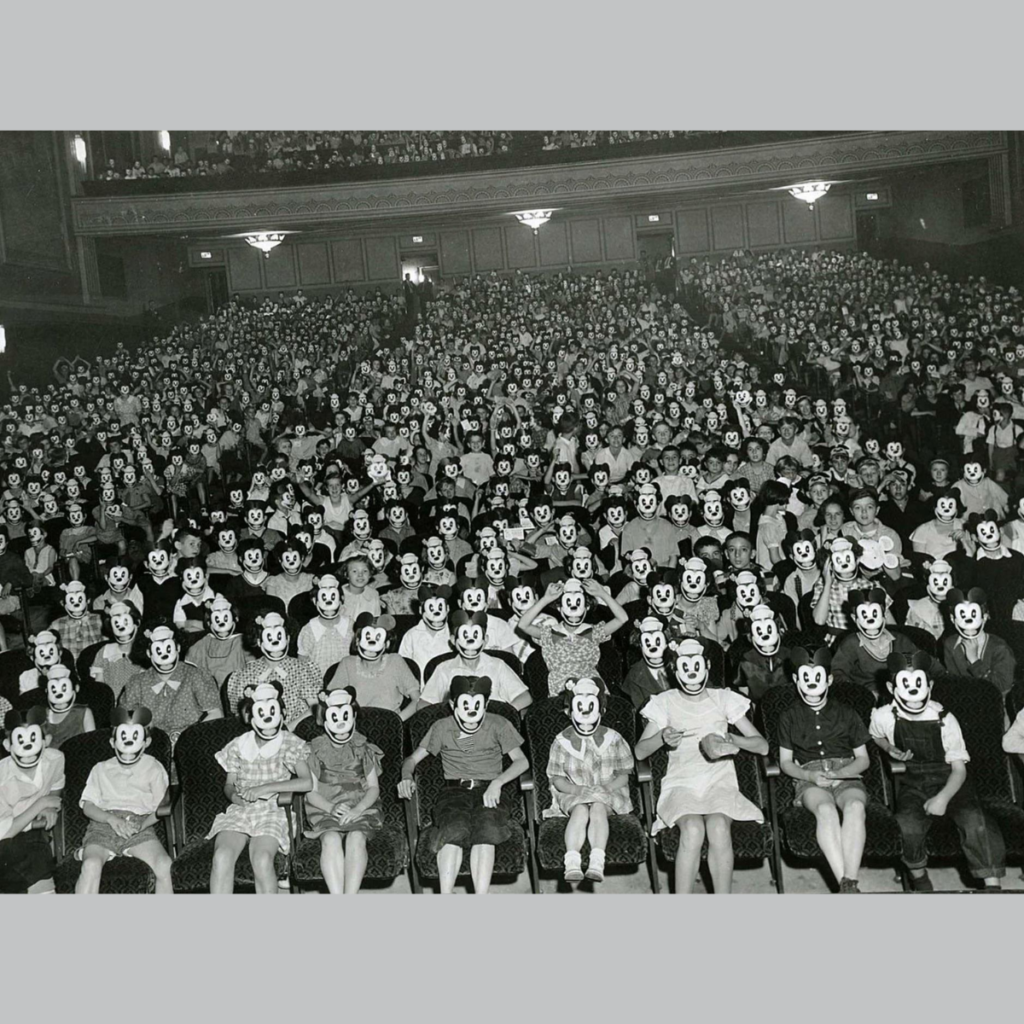

Mickey Mouse began as Mortimer Mouse in 1927, drawn by the imaginative hands of Walt Disney. By the 1930s, the Mouse was well established as part of American culture, and clubs had sprung up across America. On Saturdays, children and parents hurried to department stores where they sang and watched cartoons. To the delight of the children and the chagrin of parents, Disney merchandise was readily available. The clubs, boasting several million members, eventually disbanded because they had grown too large and too awkward to handle. In the 1950s television was still in its infancy, and it became an obvious medium for allowing America’s children to watch the show in the privacy of their own homes. Debuting in 1955, the Mickey Mouse Club quickly became a staple in the lives of pre-teens who watched the show every afternoon after school and before dinner. When it was abruptly withdrawn from the air in 1959, its fans, who were rapidly growing up, transferred their loyalties to the teen dance show American Bandstand. While the Mickey Mouse Club was briefly revived in 1977 and 1989, it is the original show that lives on in the hearts of baby boomers and in late night reruns on the Disney channel.
The debut of the Mickey Mouse Club introduced 24 young people to television audiences. Walt Disney conducted a nationwide search for personable, unknown youth who would come together for an hour each weekday to entertain America’s children. The young stars ranged in age from nine to 14. Ironically, Annette Funicello, the last of those cast, would prove to be the most popular and to have the greatest staying power. The cast was told that getting along was more important than talent. Those who could not get along, or whose parents were too aggressive, were quietly replaced. A core group of the most talented and charismatic emerged: Funicello, Sharon Baird, Darlene Gillespie, Karen Pendleton, Sherry Alberoni, Lonnie Burr, Bobby Burgess, Tommy Cole, and Cubby O’Brien. Other Mousketeers who would go on to fame were Don Grady of My Three Sons, Paul Petersen of The Donna Reed Show, and Johnny Crawford of The Rifleman. In her autobiography, Annette Funicello writes that profanity was forbidden on the lot and that respect for adults was promoted by their calling them “Uncle” and “Aunt.” Uncle Walt was obvious, of course, but the cast carried the command further by labeling the crew by names such as “Aunt Hairdresser” and “Uncle Make-up.” The adults on the show were Jimmie Dodd, a deeply religious actor, songwriter, and dancer, and Roy Williams, a long-time Disney animator.
The Mickey Mouse Club offered the consistency so important to young viewers, along with enough diversity to keep them from becoming bored. The established elements were simple: attractive young stars performing before a live audience, clowns, magicians, cartoons, guest stars, educational elements, and music written for the show. Each day of the week was devoted to a specific theme: Mondays were Fun with Music Day; Tuesdays were Guest Star Day; Wednesdays were Anything Can Happen Day; Thursdays were Circus Day; and Fridays were Talent Round-Up Day.
While cartoons were frequent occurrences, education was promoted by the regular appearance of Jiminey Cricket—from Disney’s Pinnochio —who walked children through the encyclopedia. News-reels brought events around the world to the attention of young viewers. Notable guest stars were actors James Cagney, Fess Parker, and Buddy Ebsen, and singers Judy Conova and the Lennon Sisters. Additionally, the show included various series featuring the regulars or other young stars. The most popular of these series were The Hardy Boys, starring Tom Considine and Tommy Kirk as Frank and Joe Hardy; The Adventures of Spin and Marty, with Tim Considine as Spin and David Stollery as Marty; and Annette, which ultimately led to a recording contract for Annette Funicello.
When the show ended unexpectedly in 1959, it was still rated the top children’s show of the day. In 1980, 31 members of the cast came together to celebrate the 25th anniversary of The Mickey Mouse Club. Assisted by Paul Williams, who had always wanted to be a Mousketeer, and Tim Considine, who should have been a Mousketeer, the stars danced and sang with as much enthusiasm and a lot more poise than they had at the show’s debut. Most still retained some connection to show business. Annette, who had been the only Mousketeer retained by the Disney Studios when the show ended, went on to make a series of Beach Party movies with Frankie Avalon, wrote an autobiography that became a made-for-television movie, and became a spokesperson for muscular dystrophy. Bobby Burgess spent 20 years with The Lawrence Welk Show and continues to dance. Cubby O’Brien is a noted drummer, Sharon and Sherry do cartoons and commercial voice-overs, and Lonnie is a playwright. Tommy is an award-winning make-up artist, and Paul Petersen has become a major voice in the battle to protect the financial rights of child stars.
There has been much speculation about the impact of the Mickey Mouse Club on baby boomers. Its success was not complicated—it simply provided children of the 1950s with positive role models while entertaining them and promoting self-esteem. Why did America’s young people tune in every day to watch the show? Because they believed the Mousketeers when they ended each show with the promise to return again and again “because we like you.” It was a constancy in the lives of a generation that would spend the rest of their lives looking to television for answers to society’s questions.